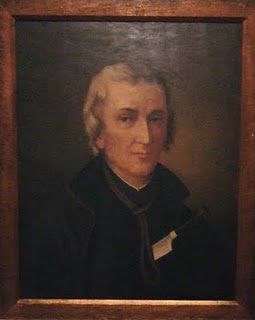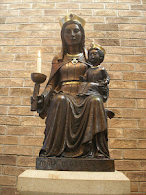On 1st November, I and six other members of Friends of Saint David Lewis had the privilege of visiting Trivor, at St Maughans near Monmouth. Because it was All Saints Day, some members of Friends of Saint David Lewis had other commitments and were unable to join us. However, we set off in two cars and indeed the saints smiled on us, for the weather was glorious with the sun accentuating the autumnal glory of the countryside.
When we arrived at Trivor, we were met by the owner, Mr Iorwerth Harries. As well as a pleasant and friendly host, Mr Harries proved to be a knowledgeable and enthusiastic guide! After greetings and introductions, Mr Harries showed us around the outside of the house, pointing out the various features. He told us that there had been a house on the site since the 1200s but, in the early 1400s, during Owain Glyndwr’s rebellion, the whole area was devastated. The present house is a mixture of periods with the oldest part being 17th century. Traces of the original limewash, on the outside front of the house, are still visible.
When we arrived at Trivor, we were met by the owner, Mr Iorwerth Harries. As well as a pleasant and friendly host, Mr Harries proved to be a knowledgeable and enthusiastic guide! After greetings and introductions, Mr Harries showed us around the outside of the house, pointing out the various features. He told us that there had been a house on the site since the 1200s but, in the early 1400s, during Owain Glyndwr’s rebellion, the whole area was devastated. The present house is a mixture of periods with the oldest part being 17th century. Traces of the original limewash, on the outside front of the house, are still visible.
 Construction of the oldest part of the property was begun in 1625 by the prosperous James family and completed about five years later. Generations of the James family were staunch Catholics and, like many other prominent Catholics in Penal Times, they suffered hardship in the practise of their religion. Walter James was one of those mentioned by William Bedloe when Bedloe perjured himself giving evidence about the nonexistent Popish Plot. Bedloe accused James of being secretary to the great Catholic Army supposedly mustering in the remote parts of Wales. Walter James was summoned to London for questioning but was allowed to return home on his own recognizance of £1,000. Fortunately for James, nothing more was heard of the matter.
Construction of the oldest part of the property was begun in 1625 by the prosperous James family and completed about five years later. Generations of the James family were staunch Catholics and, like many other prominent Catholics in Penal Times, they suffered hardship in the practise of their religion. Walter James was one of those mentioned by William Bedloe when Bedloe perjured himself giving evidence about the nonexistent Popish Plot. Bedloe accused James of being secretary to the great Catholic Army supposedly mustering in the remote parts of Wales. Walter James was summoned to London for questioning but was allowed to return home on his own recognizance of £1,000. Fortunately for James, nothing more was heard of the matter. A secular priest, Fr John Lloyd, the brother of Fr William Lloyd, frequently stayed at Trivor while tending to the spiritual needs of the persecuted local Catholics. At Trivor, the Jameses maintained a Catholic chapel on the second floor and Fr John Lloyd regularly celebrated Mass and administered the sacraments to the Catholics who assembled there. We were taken into the room that was once the chapel and shown a niche high on the wall. The altar is thought to have been below this recess, which would have held a crucifix or a statue. Being in the room where St John Lloyd had said Mass three centuries ago was an awe-inspiring experience. On the third floor there are two attic rooms which were the priest’s rooms. A spy hole from there into the chapel is still visible. We were also shown an ancient door which opened onto what some believe was a priest hole but our guide thought more likely to be an escape route. From its location, we were inclined to agree with him!
A secular priest, Fr John Lloyd, the brother of Fr William Lloyd, frequently stayed at Trivor while tending to the spiritual needs of the persecuted local Catholics. At Trivor, the Jameses maintained a Catholic chapel on the second floor and Fr John Lloyd regularly celebrated Mass and administered the sacraments to the Catholics who assembled there. We were taken into the room that was once the chapel and shown a niche high on the wall. The altar is thought to have been below this recess, which would have held a crucifix or a statue. Being in the room where St John Lloyd had said Mass three centuries ago was an awe-inspiring experience. On the third floor there are two attic rooms which were the priest’s rooms. A spy hole from there into the chapel is still visible. We were also shown an ancient door which opened onto what some believe was a priest hole but our guide thought more likely to be an escape route. From its location, we were inclined to agree with him!  We learned that Fr John Lloyd was one of the itinerant priests of South Wales who was caught up in the horror spawned by the fabricated Popish Plot. As historians now agree, the Plot existed only in the perverted minds of Titus Oates and his henchmen. Fr John Lloyd, like his brother Fr William Lloyd, was arrested. William was sentenced to be hung drawn and quartered but, a few days before the execution was to be carried out, the innocent priest died in prison from abuse and maltreatment. Fr John Lloyd was also sentenced to be hanged, drawn and quartered and the sentence was carried out at Cardiff on 22nd July 1679. Fr John Lloyd suffered the added agony of having to watch his fellow priest, Fr Philip Evans, suffer the same butchery that he himself was to undergo. Fr John Lloyd was canonised in 1970 as one of the Forty Martyrs of England and Wales.
We learned that Fr John Lloyd was one of the itinerant priests of South Wales who was caught up in the horror spawned by the fabricated Popish Plot. As historians now agree, the Plot existed only in the perverted minds of Titus Oates and his henchmen. Fr John Lloyd, like his brother Fr William Lloyd, was arrested. William was sentenced to be hung drawn and quartered but, a few days before the execution was to be carried out, the innocent priest died in prison from abuse and maltreatment. Fr John Lloyd was also sentenced to be hanged, drawn and quartered and the sentence was carried out at Cardiff on 22nd July 1679. Fr John Lloyd suffered the added agony of having to watch his fellow priest, Fr Philip Evans, suffer the same butchery that he himself was to undergo. Fr John Lloyd was canonised in 1970 as one of the Forty Martyrs of England and Wales.One of the myriad interesting facts about Trivor is that in 1845 it was sold to the Rolls family and it became part of the Hendre Estate. This is worthy of note because one of the Rolls family, Eliza, married John Francis Vaughan of Courtfield. The Vaughans were another of the wealthy Catholic recusant families who for generations had clung to the Old Faith. Eliza was from a sincere Evangelical background and shortly after her marriage she converted to Catholicism. She was a devout woman who spent many hours in prayer, tending the sick and distributing food and clothing to the poor. Eliza was the mother of fourteen children. One died in infancy and, of her remaining children, six sons became priests and four daughters became nuns. Eliza’s eldest son, Herbert, became Cardinal Archbishop of Westminster, founder of the Mill Hill Fathers, and builder of Westminster Cathedral!
Trivor was purchased by its present owners in 1982 and extensive restoration work has been carried out. However, 17th century features have been maintained in every room of this wonderful house, which looks much as it did in 1690. Original fireplaces, wood panelling, doors, beams, plaster work and much else are all there for the lucky visitor to marvel at and enjoy.
Our visit to Trivor was truly one to remember and we hope to return again in the spring when we will be joined by the friends who were unable to be with us on 1st November. Thank you Iorwerth and Harriet for making our day such a rewarding one. Thank you too for preserving such an important part of the history of Monmouthshire.
Our day wasn’t over yet though. On our way home, we stopped at Monmouth for lunch. Where did we have lunch? Well, in keeping with the theme of our outing, it had to be the Robin Hood Inn. The Robin Hood Inn is one of the oldest buildings in Monmouth and before Catholic emancipation Mass was regularly celebrated there in an upper room. But, that’s another story for another day!








.JPG)

.JPG)






All that history in one building. It's great when we preserve such places as a memorial to all who suffered for their Faith.
ReplyDeleteGod bless.
Hi,
ReplyDeleteI came across this site by accident. I am descended from Walter James of Trivor.
His daughter Eleanor married William Winter of Llanfihangel Tal y Llyn, Breconshire.
Eleanor remained an ardent Catholic and even went to court to stop Henry Vaughan the Brecon Silurist taking control of her children and their inheritance. She won by the way!! She was a brave lady in the 17th century.
The Jameses and the Winters made good marriages to preserve the strong Catholic family bonds.
Thank you for this lovely history.
Best wishes,
Breconian
Hello Victor
ReplyDeleteYes this Trivor is an amazing place & the present owners are so interested in the house & its history that they make it an exciting and informative place to visit. We were thrilled to be able to visit a place so connected to St John Lloyd and our Welsh Catholic heritage. If you are ever in this area, Trivor is well worth a visit but visits MUST BE ARRANGED IN ADVANCE.
God bless you my friend.
Hello Breconian
ReplyDeleteWhat a great pleasure it is to hear from you! Thank you so very much for taking the time to leave such an interesting comment. You are indeed descended from brave, loyal stock. Thanks for sharing your bit of history with us & if you feel like sharing more, we would love to hear it,anytime.
Thanks again & may God bless you & yours.
What a pleasant trip that was - so full of history.
ReplyDeleteI'm glad to see you are still blogging. I wasn't able to blog or read much due to illness, but I'm happy to be back again.
You have so many interesting features and articles - so very different from most blogs.
Hello Maryellen
ReplyDeleteHow lovely to hear from you! I am so glad that you are blogging again. Circumstances over the last two years have not permitted me to blog as regularly as I would like but, yes, I am still blogging. I hope, please God, to continue to do so for a long time yet!
Thanks for looking in and for your welcome comment. Please continue to do so. God bless you, Maryellen